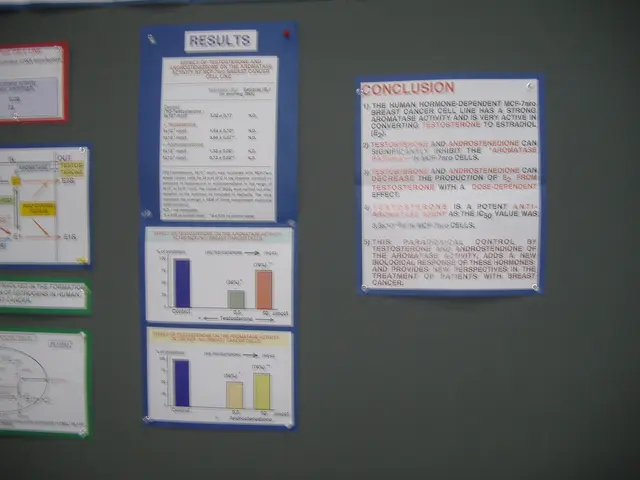Right-sided headache causes, significances, and fast-acting relief advice
Unveiling the Mystery of Right-Side Headaches: A Comprehensive Guide
In the realm of headaches, people often grapple with pain localized to one side - and that side is frequently the right one. This article delves into the various reasons behind right-sided headaches, offering practical insights for managing discomfort.
Headaches, a common health complaint, manifest in diverse forms and durations. Join us as we explore the causes of right-sided headaches and propose solutions to alleviate your pain.
Shedding Light on Right-Sided Headaches
Headaches that persistently plague a single side, like the right, might stem from:
- Medication-induced headaches: Over-the-counter painkillers, such as acetaminophen, aspirin, and ibuprofen, can result in medication overuse headaches when used excessively.
- Temporal arteritis: Typified by fatigue, jaw pain, and tender temples, this inflammation of the temporal artery primarily impacts just one side.
- Trigeminal neuralgia: Intense facial and head pain, usually affecting one side only due to nerve disruption at the brain base.
- Sinus headaches: Common among people with a deviated septum and causing headaches on the affected side.
On the other hand, headaches can also stem from conditions that usually affect both sides:
- Occipital neuralgia: While typically symmetrical, it can cause one-sided symptoms, affecting the occipital nerves between the scalp and the spinal cord.
Other potential triggers for headaches include:
- Allergies
- Aneurysms
- Fatigue
- Head injury
- Infections, including sinus infections
- Uneven meals/blood sugar fluctuations
- Dehydration
- Muscle strains or knots in the neck
- Tumors
The Headache Contenders: Primary vs. Secondary
Among the various types of headaches, migraines and cluster headaches are the most likely culprits for one-sided pain. Tension headaches might also affect one side, especially when there's neck muscle tension on that side.
Migraines
Genetics play a role in migraines, which typically manifest as pulsating or throbbing pains in the head.
When headaches consistently target the same side, it could indicate a more severe condition, such as a tumor.
Apart from persistent pain, migraines may be accompanied by:
- Blurred vision
- Nausea
- Sensitivity to light and sound
- Vomiting
Cluster Headaches
Cluster headaches are intense, short-lived headaches that recur in cycles. They typically affect one side of the face, often around the eye, and can spread to other areas, including the neck and shoulders.
During cluster periods, people may experience numerous attacks for weeks or months followed by a period of remission. Other symptoms of cluster headaches include:
- Facial sweating
- Pale or flushed skin
- Red or watery eyes
- Restlessness
- Stuffy or runny nose
- Swelling around the affected eye
Tension Headaches
Tension headaches are the most common type, affecting roughly 1 in 5 people. Some individuals may have symptoms on one side only.
Typical tension headache symptoms include:
- Dull, aching pain
- Tender shoulder and neck muscles
- Tightness or pressure across the forehead, sides, or back of the head
When to Seek Medical Attention
Though many headaches subside on their own, regular headache sufferers should consult a doctor to uncover underlying causes. People experiencing symptoms such as:
- Vision changes
- Confusion
- Fever
- Head injury
- Increased pain during movement
- Neck stiffness
- Numbness
- Personality or cognitive changes
- Rash
- Sleep disturbances
- Slurred speech
- Weakness
should seek immediate medical attention. A persistent one-sided headache may warrant an evaluation.
Frequently Asked Questions
Recognizing the location of your headache may aid healthcare professionals in diagnosing the type and planning effective treatment.
For instance, frontal or one-sided pain might indicate migraine or cluster headaches.
Some headaches might dissipate on their own, allowing you to alleviate symptoms with over-the-counter medications, rest, or home remedies.
However, severe, frequent, progressively worsening, or recurring headaches warrant a doctor's consultation to determine the root cause and develop a treatment strategy.
Dehydration can exacerbate or trigger headache symptoms; staying adequately hydrated is crucial for preventing dehydration headaches. Treatment typically involves rehydrating the individual.
A one-sided headache does not exclusively indicate migraines. Other factors, such as neurological issues, tension headaches, and medication side effects, can also be responsible.
In summary, headaches localized to just one side, like the right, might stem from diverse causes. Understanding the specific root cause and seeking professional advice can help manage symptoms and prevent long-term inconvenience.
Read the article in Spanish.
In the realm of headaches, some people frequently experience pain on one side, often the right. This guide delves into the unique causes of right-sided headaches, providing practical insights to help alleviate discomfort.
Medication overuse headaches can be the result of overusing over-the-counter painkillers like acetaminophen, aspirin, and ibuprofen. Temporal arteritis, characterized by fatigue, jaw pain, and tender temples, primarily affects one side. Trigeminal neuralgia causes intense facial and head pain due to nerve disruption, often impacting just one side. Sinus headaches, common in people with a deviated septum, typically affect the side with the affected sinus.
Occipital neuralgia, although usually symmetrical, can cause one-sided symptoms, affecting the occipital nerves between the scalp and the spinal cord. Other potential triggers include allergies, aneurysms, fatigue, head injury, infections, uneven meals, dehydration, muscle strains or knots in the neck, tumors, and stress.
Among the various types of headaches, migraines and cluster headaches are the most likely causes of one-sided pain. Tension headaches might also affect one side, especially when there's neck muscle tension on that side. Migraines are often pulsating or throbbing and can be accompanied by blurred vision, nausea, sensitivity to light and sound, and vomiting. Cluster headaches are intense and short-lived and recur in cycles, causing intense pain on one side of the face, often around the eye. They are also accompanied by symptoms like facial sweating, pale or flushed skin, red or watery eyes, restlessness, and swelling around the affected eye. Tension headaches are the most common type and are characterized by a dull, aching pain and tightness or pressure across the forehead, sides, or back of the head.
Regular headache sufferers should consult a doctor to uncover underlying causes. Symptoms such as vision changes, confusion, fever, head injury, increased pain during movement, neck stiffness, numbness, personality or cognitive changes, rash, sleep disturbances, slurred speech, weakness, and persistent one-sided headaches may warrant medical attention.
Some headaches may dissipate on their own, while others require a doctor's consultation to determine the root cause and develop a treatment strategy. Dehydration can exacerbate or trigger headache symptoms; staying adequately hydrated is crucial for preventing dehydration headaches.
A one-sided headache does not exclusively indicate migraines. Other factors, such as neurological issues, tension headaches, and medication side effects, can also be responsible.
In summary, headaches localized to just one side, like the right, might stem from diverse causes. Understanding the specific root cause and seeking professional advice can help manage symptoms and prevent long-term inconvenience. It is essential to pay attention to the location of your headaches for better diagnosis and treatment.







